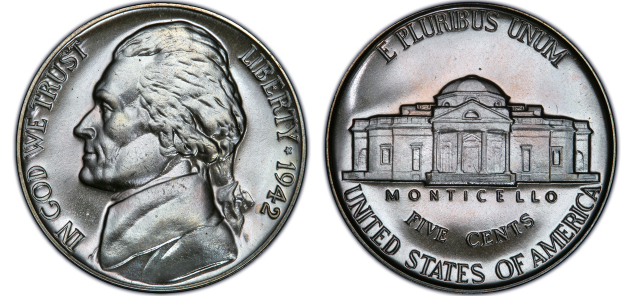1942 Jefferson Nickel (P, D, S): Values and Varieties
1942 was an important year for coin collectors. It was the first time the Philadelphia Mint used the P mint mark on its coins. It was also the only year that two types of Jefferson nickels were made using two different metals.
Shortages of nickel metal for the war effort in World War II meant that the US Mint had to find a substitute metal for 5-cent coins. The new coins would need to have the same weight and size as regular nickels and also be accepted by vending machines. The Mint chose an alloy of 56% copper, 35% silver, and 9% manganese to replace the traditional 75% copper, 25% nickel alloy.
Were Nickels Made With Silver?
It seems strange to us now, but not only was nickel more important to the war, but copper was, too! Dropping the copper content of “war nickels” by 19% added that much more copper to the war effort. With 90 million silver nickels made in 1942 alone, it added up.
Were Nickels Made With Manganese?
The 9% manganese in the war nickel might seem strange, but it was needed to get vending machines to accept the nickel. Vending machines used magnets to weed out slugs, so the silver nickels needed the added manganese to match the magnetic signature of regular nickels.

1942 “Regular” Jefferson Nickel (Philadelphia). 75% copper, 25% nickel. (PCGS)

1942-P Silver Jefferson “War Nickel” (Philadelphia). 56% copper, 35% silver, 9% manganese (PCGS)
How to Identify 1942 Jefferson Nickels: Cheat Sheet
As you can see, the Philadelphia Mint was the only mint to produce both Type 1 (original) and Type 2 (silver war nickels) in 1942. Denver only produced Type 1 nickels, possibly to finish off existing stocks of nickel planchets. Conversely, San Francisco only produced Type 2 silver nickels in 1942.
The silver nickels made in 1942 all have mintmarks on the reverse of the coin. What about 1942 nickels with no mintmark? These are all Type 1 nickels produced in Philadelphia.
By 1943, all three mints were making silver nickels. Production would only switch back to Type 1 Jefferson nickel production in 1946.
WHICH MINT MADE WHICH 1942 JEFFERSON NICKELS?
1942 Jefferson Nickel Prices
The most valuable coins are uncirculated ones that earn the highest “Mint State” ratings from certified coin grading services. Mint State (aka uncirculated) coins are graded from MS60 to MS70.
DID YOU KNOW?
Coins are graded on a 70-point scale, where 1 is so worn as to be almost unidentifiable, and 70 is perfect, with no damage or blemishes visible even under magnification.
1942 Type 1 Jefferson Nickel Value
MINTAGE: 49,789,000
1942-D Type 1 Jefferson Nickel Value
MINTAGE: 13,938,000
1942-P Type 2 Jefferson Nickel Value
MINTAGE: 57,873,000
1942-S Type 2 Jefferson Nickel Value
MINTAGE: 32,900,000
Finest Known 1942 Jefferson Nickels and Auction Records
This is a list of the finest-known examples of each 1942 Jefferson Nickel mintage. The auction records listed may or may not reflect the highest price ever paid since person-to-person private sales are not recorded.
1942 Type 1 Jefferson Nickel
AUCTION RECORD: $11,500 for MS-67 (2007, Bowers and Merena)
FINEST KNOWN: MS-67+ (PCGS); MS-67+ (NGC)
1942-D Type 1 Jefferson Nickel
AUCTION RECORD: $4,320 for MS-68 FS (2021, Stack’s Bowers)
FINEST KNOWN: MS-67+ (PCGS); MS-68 (NGC)
1942-P Type 2 Jefferson Nickel
AUCTION RECORD: $5,950 for MS-68 (2021, eBay)
FINEST KNOWN: MS-68 (PCGS); MS-68+ (NGC)
1942-S Type 2 Jefferson Nickel
AUCTION RECORD: $2,625 for MS-68 (2020, eBay)
FINEST KNOWN: MS-68 (PCGS); MS-68 (NGC)
1942 Jefferson Nickel Varieties and Rarities
Variety coins are coins that have had something happen to the die before the coin is struck. Common coin varieties include Doubled Die on Reverse (DDR), Doubled Die on Obverse (DDO), and Repunched Mint Mark (RPM.)
The difference between variety coins and error coins is that variety coins result from a mistake on the coin die. Many hundreds or even thousands of variety coins with the same defect can be minted before the mistake is noticed.
1942-D/D Type 1 "D over Horizontal D" Jefferson Nickel
One of the most famous Jefferson nickel varieties is the 1942-D/D “D over Horizontal D.” When the 1942 dies were being prepared for the Denver Mint, the die sinker messed up and punched the D mintmark pointing down. Dies were very expensive and difficult to make, so he simply turned the punch 90 degrees and punched a new mint mark over the first one.
AUCTION RECORD: MS66, $15,275 (2013 - Heritage)
1942-P/P Type 2 Jefferson Nickel
The 1942-P/P Jefferson nickel is a variety coin that has a “normal” repunched mint mark. That is to say, both strikes are right-side-up, just offset. The 1942-P/P garners more than the usual interest since it is the first mintage in history to have the P mint mark for Philadelphia, and it’s the first year of the silver Type 2 war nickel.

AUCTION RECORD: MS66, $1,020 (2013 Heritage)

Detail of the 1942-P/P repunched mint mark. The top P is offset to the left of the original P.
Error Coins
Error coins are a result of a mechanical malfunction of the coin press or a defect or mistake in the coin blank itself. (Anything that happens to them after they are ejected from the coining press is referred to as “post-mint damage.”) This means that each error coin is unique, even if they were subjected to the same type of malfunction.
Common error coins are
Read more about Jefferson nickels from the expert authors at Gainesville Coins:
1942 Nickel No Mintmark: Values & Strange History Explained
What Is a Silver Nickel Worth? (More Than You'd Expect!)
15 Most Valuable Jefferson Nickels: Complete Price Guide
No Date Buffalo Nickels: How to Find Their Value

Steven Cochran
A published writer, Steven's coverage of precious metals goes beyond the daily news to explain how ancillary factors affect the market.
Steven specializes in market analysis with an emphasis on stocks, corporate bonds, and government debt.
